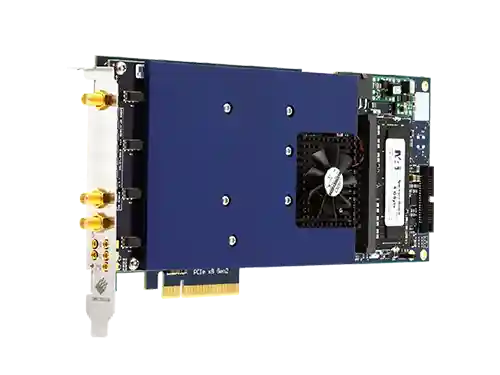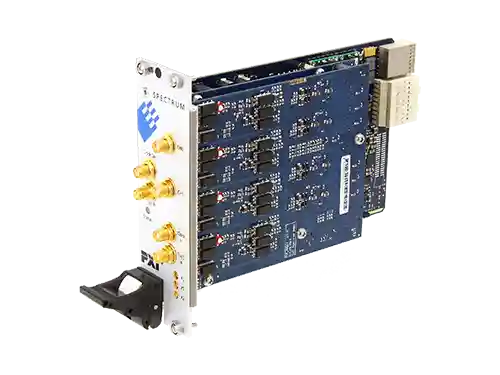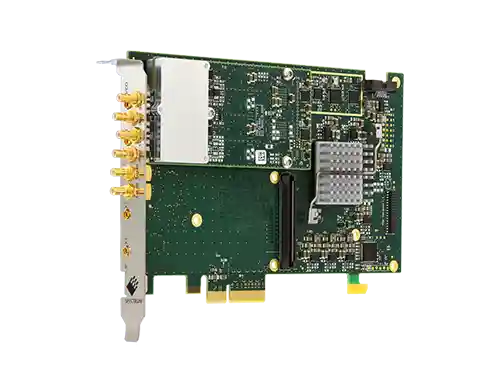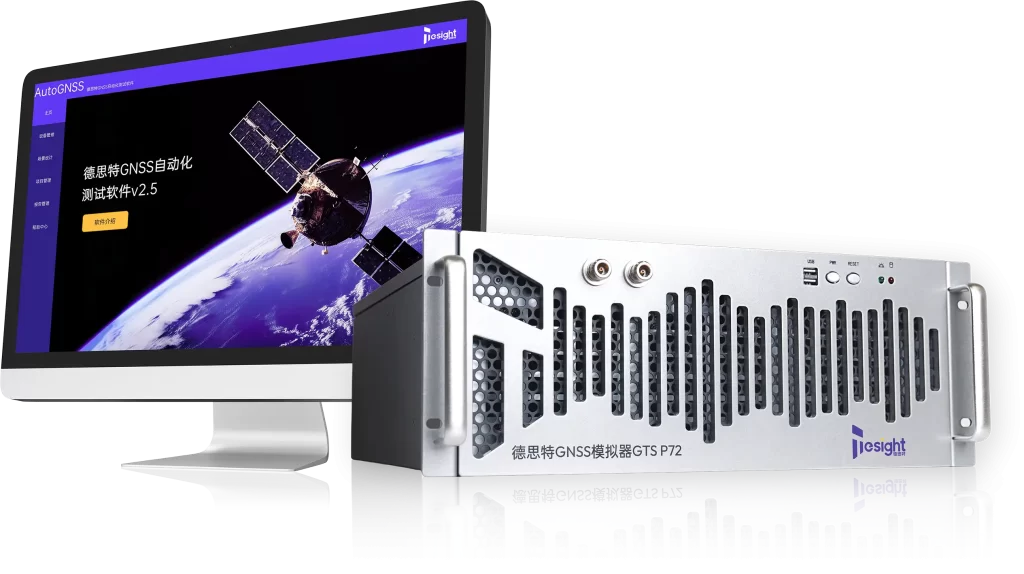- Home
- Technical Products
Enterprise Cloud IT Solutions
Test Measurement
Industrial Measurement
- Solutions
Enterprise Cloud IT Solutions
Test Measurement
- Latest Articles
- About Us
 EN
EN
高速數位化儀

Highly Accurate Data Acquisition Solution Breaks the Transmission Speed Barrier
虹科數位化儀采樣率高達5GS/s,可支持128個通道同步采集,具有8/12/14/16位模擬分辨率,符合目前最常用的行業標準,包含LXI、PCIe、PXIe,配套軟件可以使用產品示波器、數據記錄儀、數據采集系統、頻譜分析儀、邏輯分析儀、碼型發生器、數據流系統(FIFO)和瞬態記錄儀等多種儀器功能
5 GS/s
Sampling rate
128 channels
synchronous acquisition
8/12/14/16 bits
Simulation Resolution
promise to keep sth. in good repair
0 surname Nian
backwards compatibility
0 surname Nian
Made in Germany
0 %
Product Type
0
Various models available
PXI/PXIe board type PCI/PCIe board type LXI desktop type
Wide range of applications
Acoustics
The measurement and analysis of sound waves propagating through air, solids and liquids is important to many industries involved in production testing, machine/engine performance and process control. Signals detected by sensors such as microphones and accelerometers can reveal critical information about the behavior and actions of an object. Sound waves can also be used for acoustic localization. Active techniques use sound generation and study the echo response, while passive methods monitor the generated sound or vibration and then try to determine the direction and location of the sound source. Perhaps the best known method of acoustic localization is sonar, in which a water listener is used to monitor waveforms traveling through water. However, acoustic localization is also applied to other media and plays a key role in materials science and geology.
aerospace
The aerospace industry utilizes a wide range of technologies in the continuing quest to improve aircraft control, efficiency, range, payload and life. Materials science, communications, aviation, and engine/propulsion technologies are all key research areas, and each uses electronic signal testing to help determine performance. In materials science, for example, new products and compounds need to be characterized and identified to understand how they will perform under different conditions. To do this, engineers conduct extensive testing on materials to understand their behavior under a variety of conditions such as stress, strain, vibration and temperature. Sensors for critical parameters such as strain, force and acceleration generate the electronic signals that need to be captured and measured.
Astronomy
Although astronomy is one of the oldest scientific disciplines, it is still at the forefront of technology and engineering, and while the 20th century was once limited to observations of visible light (primarily the night sky), many new ways of exploring the universe have emerged. Using instruments that are sensitive to an ever-expanding portion of the electromagnetic spectrum, scientists have been able to detect many previously unknown phenomena and look deeper into space than ever before. The development of radio telescopes can reveal the remnants of exploding stars, while higher-energy instruments, such as those using X-rays and gamma rays, have made it possible to study the behavior of matter in extreme states, such as those found in pulsars and flares.
ATE
Computer-controlled testing helps increase manufacturing productivity by improving efficiency and quality. Automated test equipment (ATE) plays a vital role because it allows for more rigorous testing to be performed in a faster and more controlled manner than was previously possible using manual procedures. An ATE may involve a single measurement carried out continuously at a very high rate, or it may involve multiple measurements carried out by many different instruments. Measurements made on the device under test (DUT) or unit under test (UUT) are usually calculated, stored and analyzed automatically by some form of computer. This process helps to eliminate human error and allows troubleshooting to be performed in a repeatable manner, even when repetitive measurements are involved.
motor vehicles
In recent years, the increased use of microprocessors, fast communications and sensor technology has led to advances in braking systems, traction control and even accident avoidance. Modern vehicles are now using electronic ignition systems to improve their performance and efficiency, and some vehicles feature electronic engines or hybrid designs to help reduce reliance on conventional engine fuel. Safety remains a top priority for the industry, with manufacturers carrying out extensive testing and inspection throughout the production process to ensure that quality is maintained at a satisfactory level. Robotic technology is widely used in the manufacturing process to help speed up production, reduce costs and eliminate problems associated with human error.
Great Physics Trial
The mission of understanding matter and the forces of nature continues to drive larger and more complex experiments in the physical sciences. Efforts are under way to explore the universe, characterize matter and harness the forces that flow through it. To achieve this goal, scientists and engineers are building machines and instruments that are bigger, more powerful, and more sensitive than ever before.
correspond (by letter etc)
Electronic communications are constantly evolving as the international community continues to demand more and more information at faster and faster speeds. Analog and digital technologies are used for point-to-point and broadcast communications transmitted over wireless, fiber optic, and wired network systems. To develop and maintain these systems, engineers need to be able to test and verify the signals being received and transmitted. There is a need to minimize signal loss or attenuation, monitor noise, and characterize key parameters. In addition, as systems become more complex, error sources need to be quickly detected and corrected.
Fiber Applications
Optical fibers are increasingly used in a variety of applications. Their ability to transmit information over long distances at the speed of light with low loss makes them the primary medium for high-capacity, long-distance data communications. As a result, fiber optic networks can be found in telecommunications systems for both transmission and reception purposes. They are also used to provide a variety of digital services such as the Internet, high-definition television and video-on-demand.
High Voltage Test
Optical fibers are increasingly used in a variety of applications. Their ability to transmit information over long distances at the speed of light with low loss makes them the primary medium for high-capacity, long-distance data communications. As a result, fiber optic networks can be found in telecommunications systems for both transmission and reception purposes. They are also used to provide a variety of digital services such as the Internet, high-definition television and video-on-demand.
Laser Applications
Lasers are unique in that they are highly coherent. High spatial coherence means that laser beams can be focused into small spots and collimated beams can travel great distances with minimal dispersion. Lasers can also produce light with high temporal coherence. This means that the light emitted has a narrow spectrum or a single color. Time coherence also makes it possible to produce narrow pulses, with the fastest lasers capable of producing pulses in the femtosecond range. The unique qualities of lasers have led to lasers being used in an increasing number of applications. These include science, medicine, communications, chemistry, printing, data storage, imaging, welding, robotics, measurement, mapping, guidance and cutting.
Materials Science
Since the beginning of the Industrial Revolution, mankind has sought advances in materials science to help them obtain quality products with higher performance and/or lower cost. Traditionally, this has been accomplished through developments in applied physics, chemistry and engineering that have led to dramatic advances in the properties of materials such as metals, ceramics, composites, polymers and semiconductors. In recent years, materials science has even expanded into the fields of nanotechnology and biomaterials (or biomaterials).
Pharmaceutical Sciences
Digitizers are playing an increasingly important role in medical science, especially when fast electronic signals (such as those encountered with ultrasound, lasers, and radiation) need to be captured, analyzed, and displayed. The ability of digitizers to convert these types of analog signals into digital information and then transmit it to a computer at high speeds makes them ideal when information needs to be analyzed and presented quickly. Rapid medical imaging is used to improve diagnosis and help detect disease in the fields of radiology, nuclear medicine, ultrasonography, magnetic resonance imaging (MRI), optical coherence tomography (OCT) and photoacoustic imaging, dosimetry, positron emission tomography (PET), and other related non-invasive investigations.
Nanotechnology
Nanotechnology is a relatively new development and is now a rapidly growing applied science. Breakthroughs at the end of the 20th century, particularly in the field of surface imaging at the atomic level, have enabled scientists and engineers to make major technological advances in a wide range of industrial fields. These include communications, food science, medicine, microelectronics, environmental science, biology, transportation, energy, aerospace, and more.
quantum computation
The study of quantum science, and in particular the science of quantum information, is an area of research that has seen a rapid growth in activity since the beginning of the 21st century. By utilizing quantum mechanical principles, scientists are investigating the behavior of quantum bits (quantum bits of information) under different physical conditions. Instruments such as arbitrary waveform generators (AWGs) and digitizers play a vital role in this process. AWGs can generate an almost infinite range of waveforms that can be used to generate electromagnetic signals in the radio wave range to stimulate or resonate the material under study. Digitizers can capture and quickly analyze the resulting signals that reveal quantum level behavior.
Radar Applications
Advances in hardware and software technology have led to an expanding range of commercial and military applications for radar. While radar remains a key technology for monitoring aircraft and ships, miniaturization and cost reduction have allowed the technology to enter many new applications, including the automotive industry, security, NDT, meteorology, archaeology, mining and surveying.
Semiconductor Test
Modular Digitizers, Arbitrary Waveform Generators (AWGs) and Pattern Generators are rapidly becoming the instruments of choice for automated test systems used to characterize semiconductor devices. Spectrum offers these small and compact multi-channel products that comply with a variety of popular standards including PCI, PCIe, PXI, cPCI and LXI. They are available in bandwidths from 50 kHz to 1.5 GHz, sampling rates from 100 KS/s to 5 GS/s, and resolutions from 8 to 16 bits. For easy integration into ATE systems, Spectrum provides software and instrument drivers that work with 32- and 64-bit versions of Windows and Linux. Cards can be programmed in multiple languages such as LabVIEW, LabWindows/CVI, C++, MatLab, Borland Delphi, Visual Basic, VB.NET, C#, J# and IVI.
spectroscopy
Mass spectrometry is an analytical technique used to identify the chemical composition of a sample. The method usually works by bombarding the sample with electrons and breaking it into electrically charged molecules or molecular fragments. These ionized particles are then separated, usually by accelerating them in an electromagnetic field, and the mass-to-charge ratio of each compound is determined. To detect the ionized particles, an electron multiplier is often used and the results are displayed as a spectrum that plots the number of ions detected as a function of the mass-to-charge ratio. The electron multiplier plays a vital role in detecting the ions and generating the electrical signals that need to be analyzed.
ultrasound
The use of ultrasonic products is increasing as new technologies and improvements in instrument performance continue to expand the range of applications. Spectrum digitizers are ideal tools for making ultrasonic measurements and can play a key role in the development, testing and operation of these products. Spectrum digitizers and arbitrary waveform generators offer a wide range of bandwidths, sampling rates and dynamic ranges to meet a wide range of ultrasonic measurement needs. When a wide dynamic range and maximum sensitivity are required, the high-resolution 14- and 16-bit digitizers can be used to capture and analyze ultrasonic signals at frequencies from 100 kHz to 250 MHz. A cost-effective 8-bit digitizer series is also available, covering the frequency range of 5 MHz to 1.5 GHz. Typical ultrasound applications include non-destructive testing (NDT), ultrasonic wave detection (UT), Doppler effect flowmetering, time-of-flight diffraction (TOFD), ranging, scanning acoustic microscopy (SAM) and tomography (SAT), medical ultrasound and ultrasonics, phased-array ultrasound, laser ultrasound and acoustic emission.
高速數位化儀方案/套裝

TS-DAQ Series
High Speed Data Acquisition Kit
Hi-Tech High Speed Acquisition Module Host
Standard software SBench6
Matching standard RF cables
Optional Star Synchronized Trigger Module
Optional SCAPP

TS-SAS Series
High Speed Data Acquisition Kit
Industrial Controller with PCIe Slot
AWG PCIe Boards
數位化儀PCIe板卡
Programmable DC Power Supply
Signal Conditioning Module
Connecting Cables, Probes and Software
Program Resources and Technical Services
Technical Services
As a leading solution provider in the field of electronic test and measurement, we offer a full range of services including training services, project consulting and additional technical support services, testing, certification and calibration services, as well as integration and secondary development services. Regardless of the complexity of your project needs, HONGKE is committed to helping you achieve maximum productivity in the most cost-effective manner. Our professional services are designed to solve your every challenge and drive your business to excellence.
選擇最適合您的高速數位化儀/示波器板卡/瞬態記錄儀
高速數位化儀
1.25~5 GS/s
Sampling rate
1 / 2 / 4
channels
4 G
On-Board Memory
8-bit
resolution (of a photo)
±40 mV up to ±500 mV
Optional Input Ranges
高速數位化儀
130~500 MS/s
Sampling rate
2 / 4 / 8
channels
2 G
On-Board Memory
14/16-bit
resolution (of a photo)
±200 mV up to ±10 V
Optional Input Ranges
高速數位化儀
5~125 MS/s
Sampling rate
Up to 48
channels
512 M
On-Board Memory
16-bit
resolution (of a photo)
±200 mV up to ±10 V
6 input ranges available
Learn more about our products
Professional technical support from HONGKEI to help you succeed in your project.
HongKe provides professional Spectrum digitizers and data acquisition solutions, including Digitizer, Hybrid, Digital I/O, SBench6, etc. With high sampling rate, low noise and multi-channel synchronization, the Spectrum products support precise signal acquisition and real-time analysis, and are widely used in research and testing, industrial measurement and signal processing. Spectrum products are widely used in scientific research, industrial measurement and signal processing. With strong software support and flexible development interface, HongKe helps enterprises and research institutes to build efficient and stable data analysis systems that fully utilize the outstanding performance of Spectrum instruments.









